Mayan ruins, tropical rainforests, surfer beaches, and colorful towns — Central America has got it all! While there may be certain challenges to be aware of, this collection of bite-size countries is affordable, (mostly) safe, and becoming a growing backpacking hotspot.
Are you dreaming of traveling the whole region? Or maybe a specific country? Either way, scroll forth for my top tips based on backpacking Central America for over six months combined.
What’s the Gringo Trail?
If you’re looking to make an epic journey through Latin America, you will no doubt soon hear about the “gringo trail”.
Named after the Spanish slang word for foreigners, this loosely defined travel route runs all the way through Central- and South America. It is a favorite among backpackers and other overland travelers.
The Central American part of the Gringo Trail will take you at least about 2 months, give or take. This informal backpacker trail starts in Mexico’s Yucatan Peninsula, then goes down into Belize and Guatemala, and then through all the other countries until ending in Panama City.
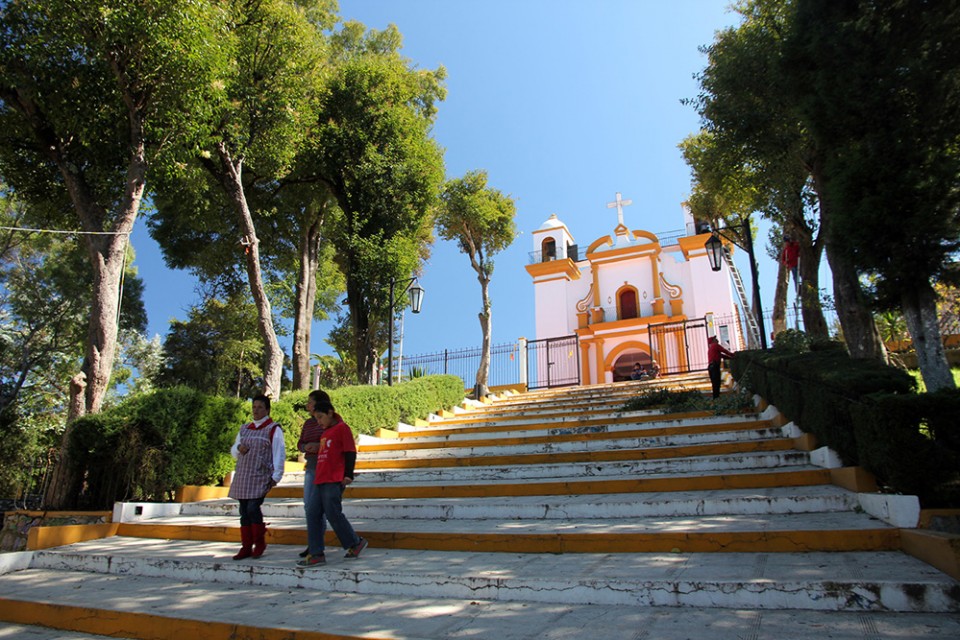
A key artery on this travel route is the Pan-American Highway, which runs from the north of Mexico all the way down to Panama City along the Pacific side. Although it’s called a ‘highway’ it’s mostly just a 2-lane road. When backpacking through Central America you’re likely to drive along many sections of it by bus. Motorbikers and other overland adventurers also follow this road often, as can be seen in the road trip documentary The Long Way Up with Ewan McGregor, for instance.
To cover the region you may end up traveling thousands of miles or kilometers, but Central America is still relatively compact. You can move around fairly quickly and visit a lot of countries in one trip.
The map below will show you roughly the ‘Gringo Trail’ that many backpackers follow. They do so either on purpose or simply by intuitively following the breadcrumb trail of backpacker-friendly destinations along this route.
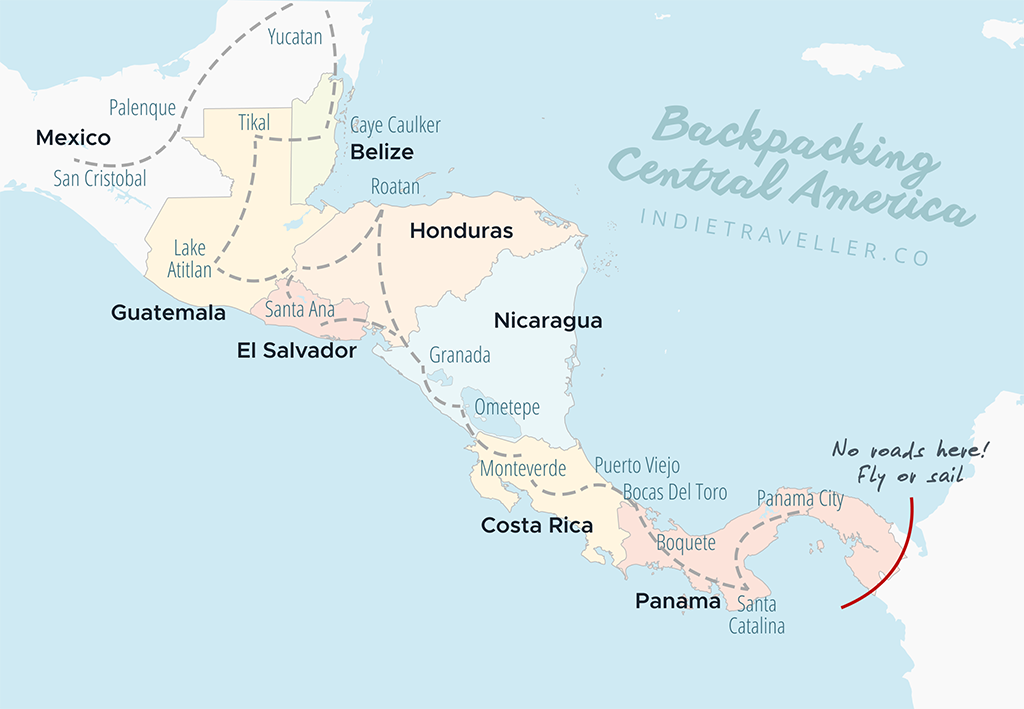
Away from the Pan-American Highway, the Caribbean sides of Honduras, Nicaragua, Costa Rica, and Panama tend to be a bit more remote and less developed. This can also, at times, make them more interesting parts to explore; for example, consider Tortuguero National Park in Costa Rica, or Bluefields and the Corn Islands in Nicaragua. Since they’re away from the main infrastructure, these places can feel a bit wilder and more remote.
On the other hand, some spots firmly on the Gringo Trail have developed into backpacker party places. For example, the Bay Islands in Honduras, San Juan del Sur in Nicaragua, or Bocas del Toro in Panama. You’ll find tons of bars, funky surf hostels, bar crawls, and all manner of entertainment in these places. Whether you wish to seek out or avoid them is up to you.
You can start in Mexico and go down or begin in Panama City and go up. It seems a bit more common for backpackers to do it north-to-south.
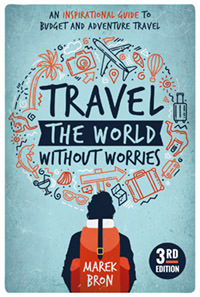
Need help with your trip?
I wrote an definitive and inspiring guidebook, which covers the whole planning process from A to Z. It teaches you everything you need to know to prepare, pack, plan, and have an amazing backpacking trip.
How much time do you need?
How long does it take to see most or ‘all’ of Central America? This is so difficult to answer. As I visit and revisit places all over the world, my conclusion is that there is never enough time to see and do everything.
Still, if forced to give an estimate I would say that six weeks is probably the ideal minimum time to do a full tour of Central America. You’ll be able to spend about a week in each country, getting a good taste of what they’re like.
If you’re a completionist, I’d recommend a minimum of three months. This is enough to hit up the key highlights, but also to poke around in some off-the-beaten-track places. You could also linger for a week here and there, perhaps to learn Spanish, to pick up surfing, or to volunteer.
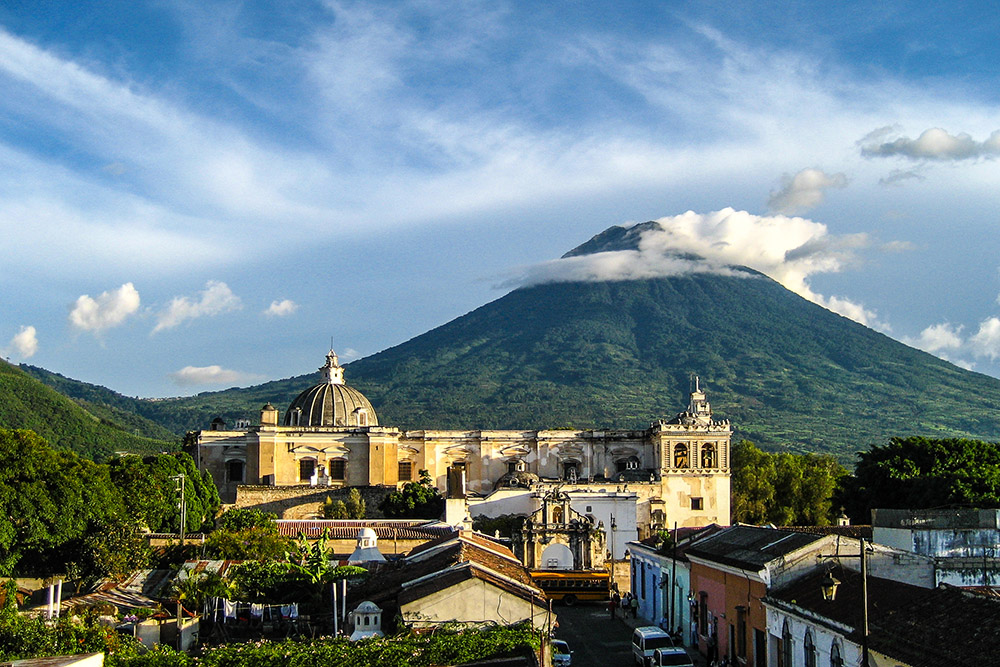
Shorter backpacking routes
If the Gringo Trail or a similar route seems a bit too much, why not bite off something smaller? Instead of doing the full monty, just pick two or three countries you most want to visit.
Sure, visiting more countries may give you more bragging rights, but it can be nice to explore fewer countries more deeply. This can often lead to more unique experiences — giving you bragging rights of a different kind.
Backpacking Southeast Mexico + Guatemala
This is a great slice of Central America to cover if you have a couple of weeks. These two countries combine well in a circular route and pack a great punch.
Southeast Mexico will give you some great beaches, Mayan ruins, mountains, and jungles. It’s an amazing and easy area to travel and will give loads of variety.
Guatemala is a great adventure-filled addition to your trip. You can visit the epic Mayan temples of Tikal (easily the best and biggest in the region) and the stunning volcano lake of Atitlan.
To do this route through Mexico and Guatemala, you’ll need about 2 to 3 weeks at a minimum, but more is always better.
Backpacking Nicaragua + Costa Rica
Another great idea for a short trip of a week or two is to focus on Costa Rica and Nicaragua. Famed for its wildlife and ecotourism, Costa Rica can deliver many epic moments even if you’re on a tighter schedule. In Nicaragua, many of the best destinations are in the southwest, very close to the Costa Rican border. This makes these two countries a perfect combo. By the way, Nicaragua is way cheaper than Costa Rica, so it can level out your overall costs a lot.
Best backpacking in Central America?
Since I had much more to say about each country in Central America, I split off my impressions into its own article. Have a look at these best countries and places to visit in Central America.
What are the hostels like?
There are loads of hostels in Central America and there are many different kinds of them. If you’re solo, it’s easy to meet other backpackers.
Many hostels are like true traveler or surfer hostels; the kind of places with lots of hammocks, a barbeque, probably some dude with a guitar, a hostel dog, and lots of travel stories flowing every evening. These are for sure my favorite type of hostels. They are often managed by local owners and tend to have a great atmosphere.
A handful of hostels are definitely party hostels — and since this is Central America, some of them party very hard. Thinking back to a few of my stays or visits to such hostels, this is where I whisper “I’ve seen things…” and probably lose myself in a dramatic flashback. I’m just saying the party scene can be a little wild. I’m too old for that now but I enjoyed the party scene occasionally when traveling Central America when I was younger.
By far most hostels are just like anywhere else though. Good vibes, nice common areas, and all the rest of it. The backpacking crowd in Central America is on average somewhat older than in Europe, Australia, or countries like Thailand. As a result, most hostels are ‘all ages’ type of places.
There is also a style of more upscale, hipstery and digital nomad-friendly hostels, most prominently from the hostel chain Selina, which originally had its first hostels in Panama. I’ve stayed in some Selinas and they are nice, though they may lack the ‘traveller vibe’ of true hostels.
Some hostels in Central America are kinda legendary and need to be booked in advance. For instance, when I was last in Panama, I was kicking myself for not getting a spot in Bambuda Lodge hostel, which has a 150 feet water slide going into the sea, or Lost & Found, an epic hostel hidden in the jungle.
Besides hostels, there is always some sort of cheap local accommodation to find. Look for hospedajes or guesthouses. While backpacking Central America, I split my time about 50/50 between hostels and guesthouses, and I liked having this mix of socializing and quieter time.
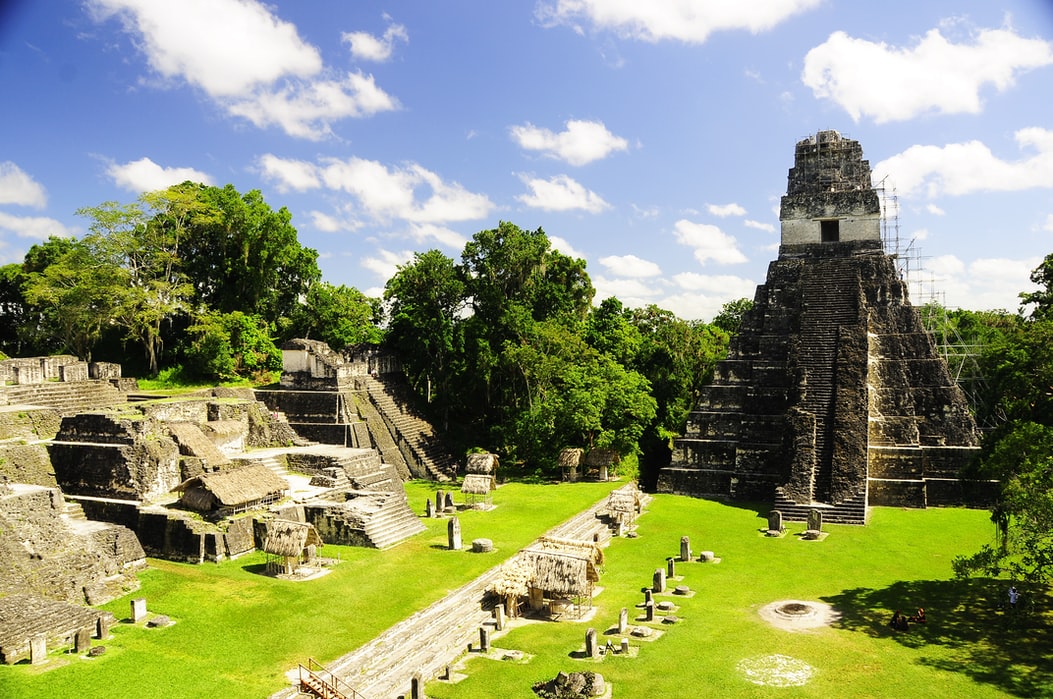
Getting to Central America
If you’re flying to Central America, then the most common entry points (with the most direct flights) are Mexico City, Cancun, San Jose (the capital of Costa Rica), and Panama City.
There are good connections with the US, but if you’re flying in from Europe or somewhere else further away, you may find there are relatively few (good or cheap) direct flights to Central America. If so, you might want to check if there are connecting flights through Miami International Airport or Fort Lauderdale Airport.
There aren’t many budget airlines operating within Central America. Sometimes the cheapest flight connection from, say, Guatemala City to San Jose might actually go via the United States! Once you’re in Central America, it often makes the most sense to travel overland by bus.
How to get around
There aren’t as many (budget) airline connections in Central America as there are in other parts of the world. Luckily the region is quite compact, making overlanding the sensible way to travel.
The cheapest — and arguably most fun — way to travel around is using local transportation. Various forms of bus services exist, letting you get from A to B at varying levels of comfort and speed.
Collectivos are short-distance minivan services. You can find them at bus terminals or you can usually flag them down on the road. While not that comfortable (I once had to ride one while hanging partly out of an open sliding door), they can be incredibly cheap. Riding a collectivo for one hour in one will set you back about $0.50 – $1.
Chicken buses are converted former US school buses, apparently named so because various goods including live chickens will sometimes be transported on them. They cover somewhat longer distances than the collectivos. Drivers will usually be shouting out destinations at the bus terminal, so just hop on board one that’s heading the right direction. For prices, think single-digit dollars. Typically you just get on board and pay later; an assistant usually comes to collect the money from you during the journey.
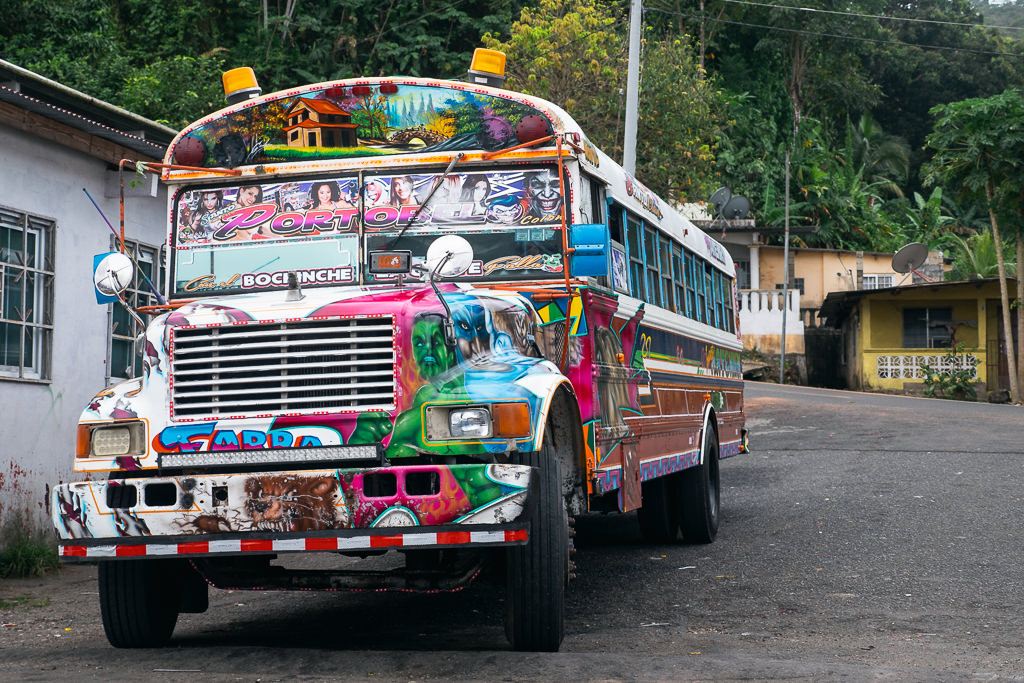
When using chicken buses, remember to keep a close eye on your bags. Some travelers don’t use chicken buses at all due to reports of crime. It’s true that generally it is not advised to use inner-city buses in capitals such as Guatemala City or Managua as these are much less safe. But outside the main cities and during the daytime, chicken buses are typically fine (but inquire locally if you’re unsure).
Long-distance coaches (usually modern two-deck buses) connect the capitals and other major hubs. Some countries also have shuttle services catering specifically to tourists. These are often a little more convenient, though they can cost as much as ten times more than the local alternatives. In Panama, I ended up using such shuttles a lot as they went directly between certain tourist destinations without any need to transfer.
Is Central America cheap?
It hugely depends where you go! Costa Rica and Belize are super expensive. Nicaragua, Guatemala, and El Salvador are very cheap countries.
To illustrate, a hostel dorm bed in Belize sets you back at least about $20 there, with private rooms starting at around $40. This is at least twice (maybe even thrice) as much as in Guatemala or Honduras.
For more details, check out my article on travel budgets in Central America. On the whole, it can be said that the region is budget-friendly, so long as you are mindful of the costs in Belize, Costa Rica, and the resort-filled locations on the Mexican Yucatan coast such as Tulum and Cancun.
How to travel on a budget
By and large, Central America is easy to do on a budget. You can keep costs down by focusing on the cheap countries, as well as just keeping your day-to-day costs under control.
For the best deals, resist buying local tours or experiences online, especially through international platforms. This is because there may be quite a markup applied by those platforms and other 3rd parties. It’s often much cheaper to organize activities locally. Most tourist towns have little travel agencies offering all kinds of activities, or you can book these through a hostel or guesthouse.
Besides accommodation and tours, food is another key expense. Honestly, Central American food can be quite samey and boring, but eating the local staples like rice, beans, plantains, and so on will definitely keep your costs low. I remember having some very filling dinner at a market eatery in Nicaragua for about $2.00. Not bad! Picky eaters may have to spend more, but if you just need to fuel up on a budget, you sure can do it.
Learning some Spanish can help you haggle as well as getting directions to more local places with cheap eats.
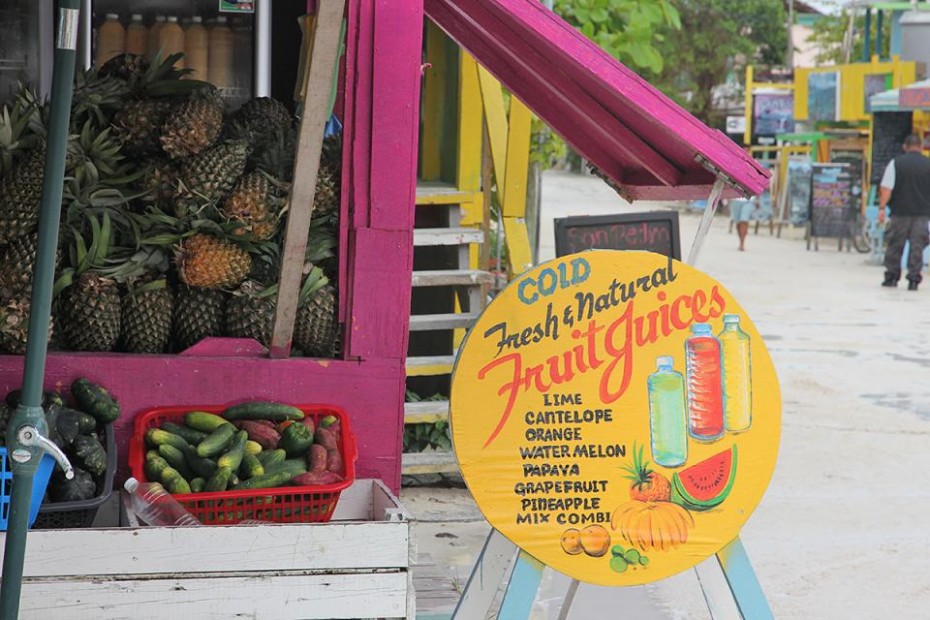
Is Central America safe?
Central America is rather safe in most countries and most of the time. In some places or countries, it’s really not so safe at all, though you can still transit safely through it. I hope that makes sense.
I used to be just all like “yaaaay, travel is amazing and you’ll never face any danger! Go with the wind!”. But as I’ve gotten older and traveled more, I’ve recognized the need to be a bit more nuanced. Situations can change and everyone has varying tolerance for (perceived) safety issues as well.
Anyway, the important thing to say is that countries like Honduras and El Salvador are honestly a bit rough around the edges. It’s wise to take a bit of extra care here. You can worry less in, for example, Costa Rica and Mexico (particularly the relatively worry-free southeast of Mexico).
People usually have excessive worries before a trip rather than too few. This is why bloggers are typically very reassuring, which is generally a good thing. All the positive stuff you’ve heard about Central America is true!
Just don’t jump in without any self-awareness or a complete lack of knowledge of the local situation. You can read a few specific safety tips for Central America.
Pssst, don’t forget your travel insurance!
Insurance in itself won’t keep you safe, but it will protect you from any financial issues if anything happens. Insurance from Heymondo covers you for medical emergencies, theft, travel delay, cancellation, lost luggage, and more.
If you’re going on, say, a family holiday to Costa Rica, you basically have little to worry about. If you’re being a bit more adventurous, I do think it helps to have some good situational awareness. It may also help to have traveled in other parts of the world first; Europe, Asia, or even many parts of South America are easier if you’re going on your first-ever backpacking trip.
For additional peace of mind, be sure to have some comprehensive travel insurance. This will ensure you’re covered in the case of any accident or theft. You can get travel insurance at Heymondo, which I use myself and recommend for any backpacking trips.
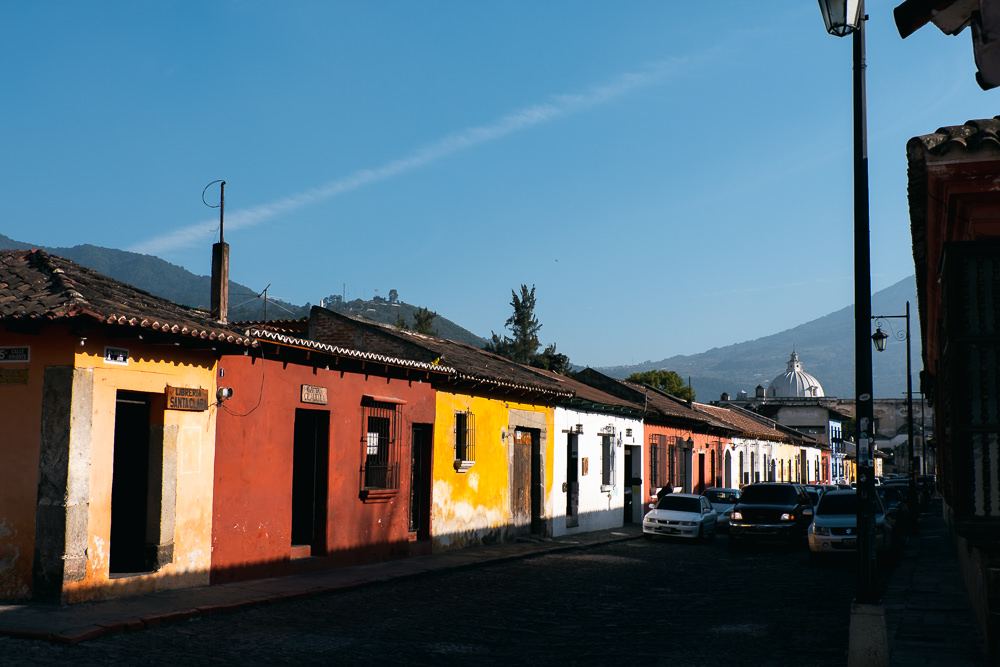
What’s the best time to go?
The best time to travel Central America is during the dry season. The exact timing of this is different in each country, but broadly speaking the dry season is between November and April.
That doesn’t mean the ‘wet season’ is all that bad. I was in Guatemala in September, which is supposedly the worst month, but I wouldn’t really have guessed it at the time. Maybe I got lucky, but I had a great experience.
Sure, it rained a couple of times. Annoyingly, it rained while visiting the incredible ruins of Tikal. Yet the tourist sights were also free of crowds and the jungles were especially lush and green. I visited Panajachel on Lake Atitlan during September and it was super chill; when I came back in December it was a cacophony of souvenir sellers, tour operators, and so on. Quite a shocking difference!
Still, the common advice is to avoid the months of July to September. Come to think of it, I did also witness the ravages of a tropical storm in Mexico during this time. I guess the dry season does offer more assurances of good weather and good vibes. If forced to travel during the rainy season, you still can though.
Keep in mind that Mexico and Costa Rica, popular as they are with American holidaymakers, will fill up a lot during US holidays such as 4th of July.
Do you need to know Spanish?
No necesitas saber español para viajar por Centroamérica, pero definitivamente te ayuda!
Sorry.
What I mean to say is that Spanish knowledge is definitely helpful. Few people in Latin America are multi-lingual and English is not widely spoken, so any Spanish you can muster will certainly be a plus.
Can you still survive without Spanish? Well, sure! Most hostels have staff members that speak different languages. Local hospedajes or guesthouses might not, but the things you need to communicate (payment, wifi passwords, food, etc.) are not exactly hard to guess.
I was with a travel buddy who knew absolutely zero Spanish. All he knew to say was ‘necesito’ (‘I need’) followed by some gesture, pointing, or showing a picture of what he needed. He got through South- and Central America without a hitch. Of course, Google Translate can also be of great help.
Nevertheless, knowing some Spanish will pay dividends throughout your trip. One thing I love about backpacking in Latin America is that you can get much closer to the local culture. In Asia, for instance, I often felt a bit trapped in the tourist bubble, usually unable to communicate with anyone local (learning Thai or Vietnamese is a bit beyond my abilities). In Latin America I could chit-chat with passengers on the bus or even date locals, adding a different dimension to the experience.
A trip through Central America is a good excuse to take at least a few Spanish classes somewhere. Chances are these classes will be cheaper than you’ll ever be able to get them at home. In another post I share my experiences with learning Spanish while traveling in Central America.
Top experiences in Central America
The region is dotted with volcanoes throughout, so while you’re here, you should climb a volcano at least once!
In Guatemala, I climbed up Tajamulco volcano at night to catch the sunrise, which was just out of this world. In Nicaragua, I hiked up to Telica volcano, which was active at the time, and you could peek over the edge and see the lava down below. Simply unforgettable. Many backpackers also speak highly of the volcanoes near Antigua, Guatemala. In Nicaragua, you can also go volcano boarding (sliding down a volcano like a sled).
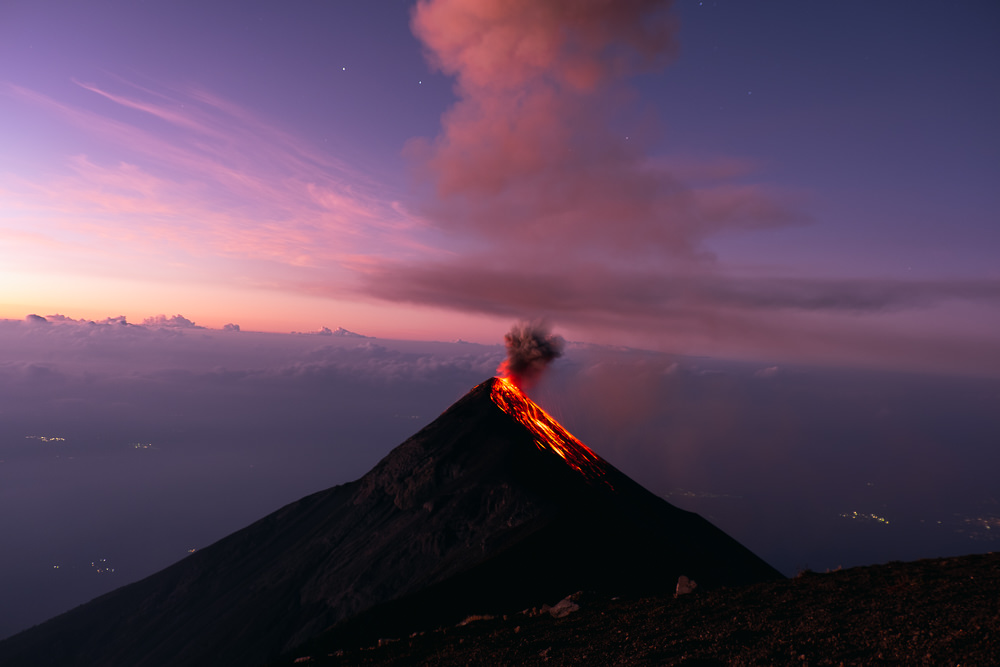
The jungles and cloud forests of Costa Rica are not to miss. Do a day hike or, better yet, get a jungle tour at night with a good guide. I was amazed at how much wildlife you could see at close range.
The epic Mayan ruins of Tikal in Guatemala are another incredible highlight. It’s a popular tourist destination but not as crowded as the different ruins in Mexico, and it’s surrounded by jungle in a remote location, adding to its mystique. Consider getting up early to catch the sunrise from one of the temples. Lake Atitlan and Semuc Champey are two other must-go places in Guatemala.
While backpacking Central America you’ll have some great opportunities to learn to surf. I absolutely suck at surfing but still enjoy trying. Lots of cheap lessons can be had especially in El Salvador, Panama, or Nicaragua.
In Mexico, it’s worth being there around Day of the Dead and other local festivities. The country as a whole is a real cultural and culinary highlight. The cenotes (river caves) in the Yucatan are amazing. You can snorkel through them or even scuba dive.
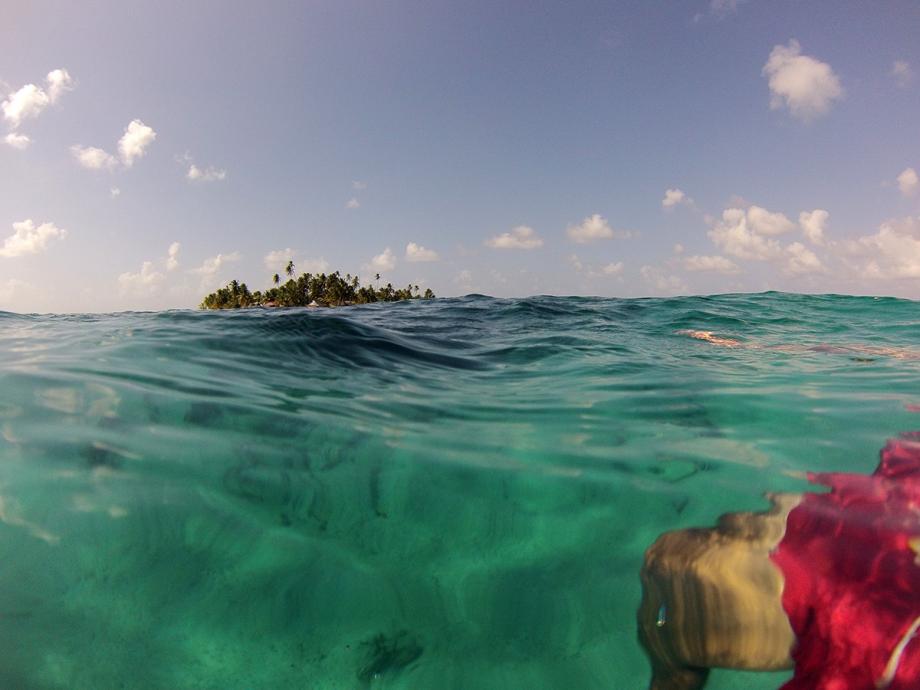
Finally, I loved the San Blas Islands off the coast of Panama. I saw these on my way to Colombia and it was one of the real highlights. My memories of staying on nearly uninhabited islands and snorkeling with giant manta rays are pretty much burned into my neurons forever.
Keep in mind that should you wish to continue your journey to South America, it’s not possible overland!
There’s a huge stretch of impenetrable and dangerous jungle in the east of Panama called the Darien Gap. There are no roads at all through the Darien Gap so you will either have to fly or sail around. I can much recommend sailing between Panama and Colombia. Many captains operate private services taking travelers to and from Cartagena. It’s an incredible 5-day trip that takes you past the San Blas Islands.
If you’re still on the fence about backpacking Central America, I hope I’ve inspired you to get off that damn fence and to start planning your trip! You definitely won’t regret backpacking Central America.
P.S. Did you find this post useful but you could use more detailed help? Then check out my book, Travel the World Without Worries. Readers have called it their “single best pre-trip purchase” and “comprehensive, informational, funny and inspiring”. The book is designed to go through every possible topic to put your mind at ease before venturing off to the unknown. I guarantee it will better prepare you for all the challenges (and fun) of backpacking Central America.
Some links may be affiliate links, meaning I may earn commission from products or services I recommend. For more, see site policies.
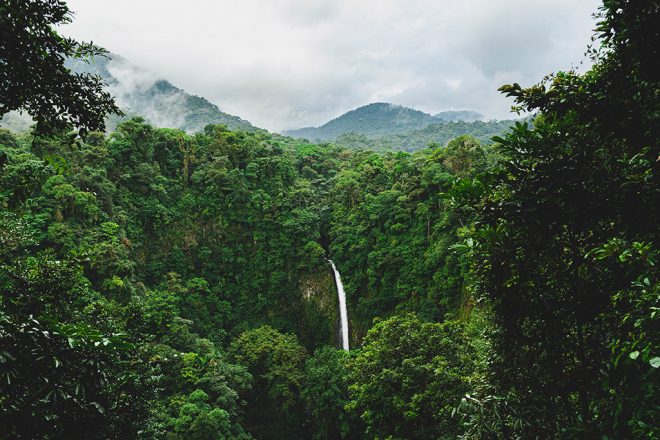
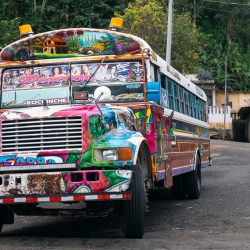





Hello Marek,
This was such a good read, we are planning to do the ‘Gringo Trail’ next October for around 4/5months. We’ve got two children, a baby who won’t yet be walking and a toddler. We know it’s going to be very different from our other adventures and we’re happy to figure it out as we go. Are we mad travelling overland with them?
Hi Sarah… it’s a good question and hard to say, as I only have a 9-month-old daughter as my personal reference right now. 🙂 I honestly find it hard to travel with a baby (I don’t yet know about kids), but it definitely gets a lot easier if you can travel more slowly.
I find the most annoying part is really changing your accommodation… gathering all the baby stuff, finding another place that has a cot, using transportation while carrying all your luggage etc. all adds to the logistics. Traveling by myself I change accommodation every 2-3 nights. With baby in tow I like to stay in accommodation for at least a week every time (or nice to have a campervan or something so you have a base). This makes it easier with the evening routine too.
It’s not mad, but need to adopt a different travel style for sure. Having 4/5 months and some patience makes it feasible! I say go for it 😀
Interesting but no Belize? Only y country down there that speaks English and you ignore it?
I count 5 mentions of Belize in the article 😉
Hi! Do you know if is it still possible to cross Belize to Guatemala border?
As far as I know Belize’s land borders are open. 🙂 You can check FB groups to be 100% sure… such as ‘Backpacking Central America’ and “PanAmerican Travelers Association’.
reading thru some of your material. I’ve been living in Leon, Nicaragua for 11 years = but thinking about returning to the USA. I’m planning on waiting until spring of ’22, AND i’m thinking if it’s my last trip i might as well take the bus and make it a once in a lifetime tour..lol .. i’m 69 years old and have never taking the bus across Central America – so heck why not? make it an ‘event’
so thanks for the info. it helped me get a general idea of the NICA thru Mexico trip. (i’ve bus’d back and forth to TICA a million times)
Glad you found it helpful. And indeed why not! Should be an amazing trip! 🙂
Marek,is nice that u try to share your adventures with others,but I’m really sick of u travelers talk to much about central America and their killings,if u guys hear one killing in Guatemala or Salvador,u keep talking and repeating the same killing over and over and over till u get tired of that one. But u guys never,never say anything at all of all the mass killings,rapes,killings in church,schools,disappearance,that happen “daily” in your own home in USA or europe,people driving trucks where there is another group of people. It’s crazy here,we are living in hell here,but u guys keep it quiet,u just like to talk about other countries,is true they are killings there too,but is the cartels or drug dealers,that they kill themselves,they are not after civilians or tourists,they don’t need your pennies they are millionaires. Just think about it & keep traveling.
I get the frustration and agree that ‘bad news’ at home often goes ignored but bad news from distant places gets much more attention. In Europe and in the USA especially there are plenty of killings and shootings. But I still think there are specific safety concerns in Central America. A traveler I met was shot at in Guatemala… in Nicaragua a guesthouse had been raided by a gang. I don’t normally mention these things because they are rare (and sometimes the traveler was stupid to get into a bad situation). But I do think Central America is objectively a less safe area than Europe where I’m from (I don’t know about the USA). Hopefully my take is balanced so that it doesn’t stop anyone from visiting Central America, just making them a bit more cautious so that nothing happens to them.
Hi! Alecia from findingfootsteps.com here, great tips! I just got back from my first backpacking trip across Central America. Definitely a learning curve, but the beauty and culture it radiates is already making me itch to go back.
Hey Marek,
Love this post, found all of the pros and cons very helpful in deciding to plan our itinerary for our first backpacking trip. How easy is it to find hostels and public transport along the way, or do you tend to book them a couple of days in advance? And how much of a strict itinerary would you say is needed in order to know where you’re going? We are booking flights to Cancun and aim to fly out of Panama City 3-4 months later. We’ve only ever done overland style trips where the logistics are already taken care of so any tips would be really helpful!
Thanks,
Frankie
Hey Frankie. I tend to book things only a few days in advance. With hostels you can often even just show up on the day, but I prefer already booking a hostel I like. With 3-4 months I would not make a strict itinerary at all – think of your route as more of a guide / wishlist! Figure out your favorite things in each country and then go from there. By the way, check out my book if you want to know more about this style of travelling by yourself. 🙂
Thanks so much for your advice! Do you use a particular app or website to book the hostels and accommodation? Ok that’s great we won’t bother making a strict itinerary! How much £££ would you suggest having to be on the safe side for a trip like this? Will definitely check out the book!
Hey Marek!
We’ve just begun planning our first backpacking trip – just said I’d drop a ‘thank you’ note for all the information above, it’s a fantastic starting point.
Best of luck with your future travels!
Denise
Thanks Denise! And best of luck on your trip 🙂
Oaxaca is by far my favourite place in Mexico 🙂 I’m looking forward to re-visiting both Mexico and Central America in the near future,
I appreciate your sharing. I also spent a really good time there during my last journey and have a joyful time with my mates. In my point of view it is a perfect place for backpacking. I would love to go there again if I get any chance.
Hi Marek,
I am planning a trip from southern Mexico and planning to fly out of Panama City 2 to 3 months later. I would like to take in most, if not all or the countries that you have mentioned above but I really can’t pick where to start. Realistically the most northern I would start is Oaxaca but I think I am too afraid of missing out on locations.
Am I being too optimistic about starting so far north and possibly leaving my self open to having to take many internal flights trying to get back within 2-3 months?
Any advice would be a major help as it is the only thing stopping me from booking my flights!
Thanks,
Paul
Hey Paul. 2-3 months for a trip starting around Oaxaca and ending in Panama City seems realistic to me. 🙂
Well, this is a nice roundup for people planning to go to Central America for the first time. Despite concerns for safety in most places, most of these destinations look awesome and 5 days would not be enough to see everything. But then… the budget.
Great post Marek, and I totally agree with your points on Nicaragua, it’s very underrated! I’ve spent the last few months in Central and I’d say Nica has been my favourite country by far. So much to see and do, and such an easy country to be in. I’ve also just published a roundup of awesome website resources people might find useful for travelling around Central. Between them they’ve got everything covered that you’ll need to know while your here…bus time tables and prices, accommodation recommendations and more.
Hey Marek,
Thanks for the post! A friend and I are flying into Mexico City and have a month to get to our return flight out of San Jose. We were thinking of going through Mexico, (maybe hopping over quickly to Cuba), travelling around Guatemala and Nicaragua before ending up in Costa Rica for our flight home. Does this sound reasonable? Or, too rushed? What would you recommend skipping to make it more relaxed?
Cheers,
Reddy
Hey Reddy! Hmm, it might be a little rushed. You mention 4 (possibly 5) countries, and counting about 1,5 days of travel time per country (assuming you’re travelling overland), you’re left with 5 or 6 ‘net’ days per country. Roads and transportation are not so good everywhere so things can move slower than in Europe or the States.
Will you be travelling around Costa Rica as well or is that just where you fly back from? I’d maybe keep Cuba for another day (so you can see more than just Havana). Guatemala is amazing and probably needs a full week to sample properly. I’d probably choose between either Costa Rica and Nicaragua.
Just my 2ct. That said, you can just go and play it by ear… see how fast you make progress and adjust your plans accordingly 🙂
Hey Marek,
Loved the post, I think everybody has pretty much covered how great it is. I was wondering how hard money exchange is from one country to the next?
Thanks,
Tracy
I found that it’s not too difficult to exchange currencies, but the rates can be bad sometimes, so I usually tried to use up my last cash before going to the next country.
Hi! ☺
Thx for this awesome info, it really helped me plan my last minute Central America trip. I’m flying to Panama City and then heading north to Mexico. I will be in total a little bit more than 2 months there (January 23rd till March 29th). Do you think I could visit all 8 countries in these 9 weeks.
I was thinking:
Panama: 4-5 days, Panama city and San Blas or Bocas del Toro
Costa Rica: 7-8 days, Puerto Viejo and La Fortuna (lake Arenal, maybe Monteverde)
Nicaragua: 8-9 days, San Juan, Ometepe, Grenada and Leon
Honduras: 5-6 days, Bay Islands and Copan
El Salvador: 2-3 days
Guatemala: 13-14 days, Antigua, Lake Atitlan, Lanquin (Semuc Champey), Flores (Tikal), Chichicastenango, Xela
Belize: 4-5 days, Caye Caulker
Mexico: 13-14, Oaxaca, San Cristobal, Palenque, Chichen Itza, Tulum, maybe Playa del Carmen
Fly back from Mexico to Panama
Is this realistic, with budget around 2000 euro? I know schedule is tight, but I’m not sure when will I have chance to visit again Central America so I’m trying to visit all countries. According to places written, where do you think I should spend more\less time?
Thx again for all this amazing tips, really helped me a lot!
Thanks Marek!! Very useful and informative stuff, helped plan my backpacking trip.
I’m traveling over 70 days around Mexico, Cuba, Costa Rica and Panama. Starting from Cancun to Panama.
Hey Marek,
Great post and I’m awaiting the guide! I’m planning to travel central America in 60 to 75 days! I was wondering about crossing country borders, how easy are they? Another question was finding the buses that take you from major city to another. Are they easily found?
Thanks
The borders require a bit of patience sometimes but it’s not been too bad in my experience. Guatemala, Nicaragua, Honduras and El Salvador share the same 90 day visa. Costa Rica can be quite particular about entry requirements, such as proof of onward travel or proof of sufficient funds, so check those requirements carefully.
Long-distance buses are fairly easily found, either online or through a local booking agency. Maybe it’s not always so ridiculously easy as in, say, Southeast Asia or Europe, but if you’re ever stuck a receptionist can usually point you in the right direction. 🙂
Short-distance buses and minivans are super easy.
Great, Thanks Marek!
Hi Marek
Great site of yours! It has really been helpfull in my friend and I.
We are two girls who are planning on traveling through Central America (Costa Rica, Nicaragua, El Salvador, Guatemala, Belize and Southern Mexico). We have set aside about 4 months to travel and we wanted know which countries we should spend more or less time in according to your recommendations? Also, do you have any safety tips? We have read a lot of stories about people getting their bags stolen, moneychangers cheating people for money etc.
Furthermore, How much would you recommend is booked from home regarding stays, travel etc.? Or should we just take it as it comes to get the best experience?
Thank you in advance 🙂
Hey Sarah! For what it’s worth, my personal favourites are Guatemala, Mexico and Nicaragua. They also lend themselves well to staying a bit longer. You can go to more out-of-the-way places, like Bluefields in Nicaragua for example.
Safety-wise… yep, things do happen in Central America. Look after your belongings closely and be careful wandering around after dark particularly in Guatemala and El Salvador (when in doubt take an official taxi). This topic is too much to cover in a comment but I have some basic tips here and my book is very helpful as well in putting any concerns at ease.
I recommend booking very little from home – only your first couple of days really. Make your bookings a day or two ahead as you travel, so only when you get to Place A, book your accommodation for Place B. This is easiest and gives you the most flexibility. You can also just wing it and show up to places, though that doesn’t always get you the good hostel or hotel you really want 🙂
Hi, Marek!
This is a great post and super informative! I’m doing some research on backpacking tourism, and we’re looking at literally every region you’ve just given tips on (never mind my personal travel goals). I thought your Your comment about subjectivity was really interesting, because What we’re doing is to better understand the attitudes/behaviors/perceptions of backpackers who travel through Latin America. Would you be willing to take a short survey about your travel experiences to touch on some of the things you didn’t cover directly in this post?
Sure Francesca, you can comment or send me the link.
Thank you so much! Here is the link! 🙂
https://www.surveymonkey.com/r/HMNC28G
Great article man! Defintely a massive help with planning my trip to Central America. I cant wait!
Hey Marek. 🙂
I want to ask you: When you write that, for instance, cost of Panama can be 30 – 35 dollars a day. Have you here included visiting things like San Blas and Bocas del toro in your cost per day? Or is that just for hostels, food and so on.
Thanks for the great guide. Really helped me.
Hey Tobias! Things like tours or transportation are included in that estimate. What’s not included is your flights in/out of central america and other such non-local costs. It’s still only a rough estimate of course. 🙂
Hey, Marek!
Great guide! Me and a friend are currently living in Mexico, and have already done a lot of travelling within the country. We have also visited Cuba, Guatemala and Belize so far. We were thinking of doing a ~20 days trip in late June/early July working our way through the mid and southern parts of Central America. Nicaragua, Costa Rica and Panama are absolute musts, while we have not yet decided on El Salvador and Honduras.
I really only have two broad questions for you:
1) Would we able to do all of those five within 20 days, counting traveling days? I saw that you already state a preference for longer stays and fewer countries, so I should mention that we in general the other way around. We did for example go through Guatemala and Belize in seven days, and felt quite content. Would you say that those countries need more time than Guatemala and Belize, or about the same?
2) We would surely try to take buses instead of flying between each country. What’s your experience busing between the aforementioned countries? Any of the borders better/worse than others? From/to which cities is it easiest to find a bus? Any companies to recommend?
Hey Peter. 5 countries in 20 days I suppose is possible, though then you’d have on average 4 days per country (maybe 2,5 or 3 days per country net, if you’re not counting travel time or working around local bus schedules). That probably limits you to one or two places max in each country. I know you said you prefer to go broad but I’d probably try to hone in on Nicaragua, Costa Rica and Panama as they make for a nicely compact circuit giving you more time to go sightseeing in each country. Nicaragua, Costa Rica and Panama are all a lot more packed with things to see and do than Belize which is quite small and which you can more or less ‘see’ in a day (at a quick glance anyway).
Long distance buses (e.g. between capitals) are reasonably comfy and quick. For instance between Managua, San Jose, and Panama City there are good quality buses (like tour buses, similar to those in Mexico). Local buses can be a bit of a pain especially in Nicaragua/Honduras/El Salvador though – often these are slow and somewhat stressful chicken buses. Costa Rica has more modern and convenient local buses.
This was huge! Thank you for helping me plan my trip from Santa Cruz to Costa Rica.
Hi,
I’m backpacking Central America (Panama – Mexico) starting in a couple of weeks. I was just wondering if you’d had an experience with Corcovado National Park as I think it’s somewhere we want to visit but have heard it’s pretty difficult to get to. Any advice would be appreciated!
Thanks.
Not been there, sorry!
Any recommedations on which time of year is best for doing the 1.5 months itinerary? currently an UK student so only get June-Sept as a long enough period of time.
The weather is different per country with somewhat different high seasons. Don’t worry too much though… you can have a good experience even in rainy season, especially if you keep your plans a bit flexible.
Is it required to book a return ticket when flying into Guatemala? I plan to visit in May but do not know how long I will be staying as I plan to visit other countries.
Flying on a 1 way ticket is a complicated subject. See this post for more. You probably can go to Guatemala on a 1-way perfectly fine, but there’s a small chance you might get unlucky. (Though it’s usually easy to deal with this if give yourself enough time at the airport, see the linked post.)
Hi Marek,
Great article, thanks for putting that together. I found it very helpful. I will be travelling Central America from mid-February until mid-June but want to spend 3 weeks at the beginning of the trip surfing and working on my Spanish in one location while I wait for a friend to arrive to Costa Rica. I was thinking Puerto Viejo would likely be my best bet. Any input would be greatly appreciated.
Adam
Haven’t been to Puerto Viejo – hoping to go back to Costa Rica at some point to see it. Maybe other people have some input on this!
Hello Marek,
I’m backpacking central America (except Honduras) next october-november for 2 months
im planning to start in Mexico City -> Cancun -> Belize (not sure) -> Guatemala -> Nicaragua -> Costa Rica -> Panama
Can you tell me please, how many days i need to stay in each country ? for example, 10 days for each country is it enough? or not?
thanks a lot, your post is awesome!
Hah these questions are getting increasingly tough to answer as everyone has a different travel style and goals.
I guess I should say 10 days per country is tight, but sufficient if you pick out the top things you want to see for each country. Personally, I’d spend fewer days in Belize (it’s more expensive there and you can have similar activities/sights elsewhere for less) and fewer days in Panama (maybe 5 or 6 days… bocas del toro and the san blas islands are really nice). This stuff is not without controversy though… a while ago a Panamanian gave me a very hard time for giving this advice 🙂
Probably the best way is to play it by ear a little bit. Don’t book everything in advance, but go with the flow, and stay longer or move on depending on how you feel.
First of all, Thanks a lot for your answer!
I am debating between the trail i described, i thought maybe to dedicate these 2 months for mexico (north+south+cancun) 35-40 days, belize 3-4 days and Guatemala for 20 days. About beaches, it is less relevant but i don’t exclude this
What can you recommend? To visit most of the countries or to visit mexico,belize and guatemala and exhaust these countries?
If you do that you’ll definitely get the full taste of Mexico and Guatemala. You’ll be able to take detours, follow tips from other travellers for cool places to see, and generally not rush so much. This is how I love to travel and so I’d say that’s a great plan, though I know some people are happier ticking more stuff off the list on a single trip.
If you want to see wildlife Costa Rica is probably the best place to do it (better than Mexico/Guatemala), and Panama has some amazing islands. But in terms of culture, beaches, volcanoes, Aztec ruins, etc. Mexico and Guatamala will give you some of the best sights.
Hi Marek, my wife and I have 2 months to travel from Mexico City to Panama, which averages 1 week per country. Reading you comments above 1 week per country sounds a bit tight. If you had to skip one (to two) countries to move at a slower pace which would you skip? Perhaps one has more of an overlap on sights and activities that we could do elsewhere? Thanks for such a useful travel guide!
1 week per country is indeed pretty tight. There’s an element of subjectivity of course, but I’d probably skip or spend less time in Belize and Honduras (as similar sights/activities things can be done elsewhere). I haven’t been to El Salvador… surfers love it for the waves though I know there aren’t a lot of ‘tourist sights’ there necessarily. From what I’ve heard El Salvador more about discovering local culture which can be tricky if you’re on a tight itinerary.
Hi, I found your blog by Googling for general Panama prices. Am in need of a very cheap vacation and the flight there is cheaper than other parts of Central America, but it seems the daily costs would outweigh the ticket price. Thanks for the great summary.
I actually stayed at Robert Broz Moran’s house in Suchitoto, so it’s funny to see his comment. Loved El Salvador, AND the off-the-beaten-track parts of Honduras :).
I believe the reason Costa Rica is still showing up on these budget lists is because it used to be cheaper, and people are using old info for these “listicles”. OR maybe it’s just that the people writing them have a different idea of “cheap!” I went in 2004 and was hard-pressed to spend as much as $25/day…I realize that’s a long time ago, but this budget was achieved sleeping almost entirely in private rooms and eating in (local-style) restaurants rather than street food/bakeries.
Your informations helped me quite a bit putting my route together, thanks! 🙂
This route which i call the ‘Mayan Circle’ was a lot of fun with so many different things to see and experience. Being able to fly to Cancun and also end there was very convenient and cheap. It took us 4-5 weeks, i can definitely recommend it!
https://www.youtube.com/watch?v=VC1tgy_neD4
SUch a f**kin awesome video!!
Hi!!
this is such an AWESOME, inflormative blog! I’m new to the whole “backpacking” idea but i’ve had an urge to get out and adventure…so don’t laugh if this sounds stupid, but where do you stay while backpacking? hostiles along a trail or in the city?
thanks!!
Hi Courtney! Mainly hostels and budget guesthouses/hotels, both in villages and cities. By the way, backpacking as a form of travel typically involves taking local transportation between places (buses, trains etc.) so the idea of a ‘trail’ is a bit more abstract than with hiking or trekking trips (where you literally follow a trail on foot). With travel backpacking you typically end up going from hostel to hostel (or hotel) and using those as a base for sightseeing and exploration.
Hello Marek!
Im planning a solo backpacking trip through Central America. Im spending two months in Granada, Nicaragua where I’m volunteering through a non-profit company and then plan on backpacking to Merida, Mexico where I’ll do another volunteer project through the same company. I would like to go through Guatemala and spend some time volunteering there. I saw you mentioned some friends stayed and did that. Are there other ways to volunteer there besides doing it through a large company? Also, what would you recommend for the best method of transportation? Thank you!!
Emma Tordoff
My knowledge of volunteering options is fairly limited, sorry! Maybe another reader can comment on this. As far as transportation goes, for short distances you can use hop-on-hop-off minivans or local ‘chicken buses’, for longer distances there’s regular buses which are easy to book ahead the day before. There are small travel agencies everywhere selling these tickets, or you can get them through a hostel/guesthouse, or at the bus station itself.
I am flying into Panama October 9th and then taking the Gringo trail North until I hit Mexico. Likely trekking until late November. Should I have weather concerns? Is this a less than desirable time to travel? Will I end up just being miserable and rained on the entire time?
I travelled the region in these months and it was fine, apart from some sustained rainy days in Belize on the Caribbean coast, which I’ve heard is common there in these months. Everywhere else was basically sunny and nice.
Good to know! Thanks for the insight.
Really useful guide. Going through central america in a few months, starting in Colombia and sailing round to Panama and working my way up before heading to Cuba before flying back. Got plenty of useful tips!
Hey there thanks for all the great info.
Just wanted to double check i dont see you talking about resupply using mail drops. Are you able to hike through central America without using any transport and be able to resupply on food when needed?
My brother and i are starting in oregon and making our way down to peru.
Sorry, your question slipped under the radar somehow! Not sure as I only really have experience backpacking in Central America in the travel sense and not in the sense of trekking/wilderness hiking. I’m not sure if it’s possible to trek through self-sufficiently/unaided – maybe someone else can weigh in.
Thanx Marek, great site! Good info! I started travel at 49 and can’t get enough. Was going to go back to SE Asia/India and see the places I hadn’t before, but am thinking of probably flying into Mexico City then going south until I run out of money or until I fall off of the end of Chile/Argentina…. plus Cuba! I’m thinking spring of next year. Thanx! t.
If you make it to Costa Rica and you plant to take the western side to Panama CIty, stop in David, Panama, its a great little city super close to beaches, hot springs, Boquete, and rain forrest, the best place to stay is http://www.bambuhostel.com which sports a pool, lush gardens and a backpackers dorm built on stilts from bambu and other native woods…
Hi Marek! Me and my partner are planning our first back packing trip together. We are going to start from Mexico(Cancun) then to Guatemala and Belize and either Costa Rica or Panama for 22 days. I just had a few questions.
Is that long enough to see 4 countries?
Should we head Costa Rica or Panama for the final leg before we fly back home to the UK?
What advice could you give us with regards to keeping safe (as we do not know what to expect) as well as seeing the best sites?
I look forward to your response
Hmm, that’s less than a week per country which seems a little tight.
It’s up to you of course: some people prefer to see a few things in several countries instead of seeing more things in fewer countries. I personally really like the latter as you cut down on your time in transit (relative to time spent seeing things) and you get more opportunities to see interesting things besides just 2 or 3 main attractions in a country.
Getting from Guatemala to Costa Rica or Panama takes a long bus journey. It’s probably 2 travel days to get there, so I would maybe not try to make it there and focus on Mexico/Guatemala/Belize. You could try flying but it seems like a bit of a detour.
Some safety tips here: https://www.indietraveller.co/central-america-safety-tips/
Hi Marek. Thank you for your reply. Sorry I should have mentioned that after seeing Mexico, Guatemala and Belize that we will take a flight from either Guatemala or Belize (whichever country we visit last) directly to Costa Rica. Also how easy/safe is it to find accommodation as we are first timers to this. What advice could you give us?
Are you planning island hopping in the Caribbean in the near future…..??
Hello Marek,
Thank you so much for this detailed guide. I have used it to plan my trip from Colombia up to Mexico and across to Cuba. Would you be able to point me in the direction on advice on money? I am not sure if I should bring USD to exchange in each country or British Pound Stirling? I will obviously bring bank cards with me but in general I was wondering how you managed your money whilst travelling through central america.
thank you
Clare
USD and GBP are both easy to exchange, though USD is easier to pay for things with in a pinch if you don’t have local currency. I tend to take a bit of USD with me for emergency purposes but use bank cards primarily. A bit more detailed advice on this (pros/cons, banking fees, etc.) is in my book.
Look into Cuba closely – getting money out there is not always easy and bringing cash is a good idea there (US/Cuba rapprochement may change this situation in the future). Some details on this in my Cuba guide https://www.indietraveller.co/cuba-travel-guide/
thanks for such a quick response. Heading out today!!
Hiya,
Anksfor the guide I have already asked one question but circumstances changed and I have another now!
I am flying into Cacun, Mexico on Tuesday and will have a month to make it down to my planned flight aback home from Nicaragua on 17th April. Is this enough time? And is there anywhere I should avoid or cut short to spend more time? My main focus I reckon is going to be Guatemala, Nicaragua thanks!
Due to certain circumstances I can’t make it to Costa Rica or Panama.
Thanks!
Emily 🙂
I loved Guatemala, and I think San Pedro is a cool place to hang out a big longer! 1 month probably means you’ll have to keep pace a bit, but it should be fine. Nicaragua is quite compact (the part that has the most sights, anyway, they’re all quite close together) so here you could probably spend a bit less time, if you have to prioritize.
This is very helpful, Indietraveller! Next school year (fall/winter 2015) my 13 yr old son and I plan to backpack through Central America for 2-4 months while he does virtual school, and I work on my travel blog. We want to do 2-4 weeks of Spanish classes on a budget and then make our way from Guatemala down to Panama (possibly Cancun since the flights may be so much cheaper). We will make time for volunteering, surfing lessons, snorkeling, a cooking class, and etc. Probably spending about a week in one spot and then moving on. Here are my questions: Do I have an safety concerns? Is it realistic to budget up to $50/day for both of us (staying in CLEAN hostels or budget rooms or 1 week rentals)? Can anyone recommend a cheap, quality Spanish school for adults and kids classes? Is it possible to find small paying jobs like in cafes or teaching English? Anyone have an itinerary suggestion? I’m ok skipping Belize and El Salvador. What’s the best and fastest way to get from Cancun to Guatemala?
Hey Kristin! Sorry I didn’t spot your post earlier. Two questions I can answer quickly: personally I’d agree that $50 a day is a realistic budget. You can find budget rooms in hostels and guesthouses for around $15-20 a night that are clean and nice (but not luxurious). There’s two common routes from Cancun, one is to head down the coast to Chetumal, and then bus it to Santa Alena / Flores in Guatemala. There’s some great beaches along the way if you want to break up the journey. Another is to go to Palenque in Mexico and then head east into Guatemala.
hiii, im backpacking central America (except Honduras) this summer by myself and this was very helpful on deciding approx. how long to stay in each country. I would like to know how much was everything in san blas islands and how do you get there? How long would you say to stay there? Would you say since belize is expensive for a weekend 3-4 days in caye caulker is alright? Appreciate your advice!! THANK YOU
The Sanblas Islands are gorgeous. I saw them while sailing to Colombia from Panama (https://www.indietraveller.co/crossing-darien-gap-by-sailing/). But there are other ways to enjoy these islands. This site has some good info on San Blas: http://sanblas-islands.com. A lot of people I met stayed in Caye Caulker for 3-5 days or so, there’s enough to do there for a couple of days before moving on.
Heya
I was looking at going to Central America for 3 weeks, do you think that is enough time to do Ncaragua, El Salvador and Guatamala justice? Any advice would be great!
Hmm, good question. It’s always very personal and all depends on what you want to get out of your trip.
I would probably say to really take in much of Guatemala you need at least two weeks. That’s if you want to stay around lake atitlan for a bunch of days, soak it all up, etc. But then again, if you keep the pace up and you don’t stick around anywhere for too long you could certainly do 3 countries in 3 weeks. You’d just have to set priorities and leave some places/sights aside.
Maybe it’s best to start with the country you are most eager to see, and then play it by ear.
Thanks a lot! 🙂 Turn out that what I needed to be back for has been cancelled so I may well be there for a good few months! 🙂
Great guide, lots of useful tips!
Incredibly useful stuff! My partner and I just used your guide plus a few of the country ones to plan our travel itinerary for 2015, when we finally leave Costa Rica for good and start travelling north of Nicaragua! Very awesome, thanks for writing it all out 🙂
Glad to hear! 🙂 A lot of travel info is of course inherently subjective, though I try to make these posts as useful as possible. Good to know it helped you guys out!
Yes, of course! Actually, Luke and I had already selected which places we wanted to visit (a few of which are ones you had pointed out) but were struggling to see which routes through the countries would best connect them. We were struggling to decide on which Mayan ruins to stop at as well!
whoops you missed El SalvadorCentral Americas smallest country and athough feared by many due to rants about the violence and gangs, definitely worth mentioning if not for a 3-10 day visit to explore.
I am an expat from California, now living here for around 20 years. Many skip this tiny but by far most undiscovered and friendliest country in Central America.
For travel links check out http://www.theotherelsalvador.com or write to me at rpbroz@gmail.com for help with itinerary and trip planning.
Regards from Suchitoto, El Salvador
Robert Broz Moran
You’re right to point this out! It’s the only country I missed seeing (though not for any particular reason, just circumstance) so I did not feel I could write properly about it. Your website seems very useful.